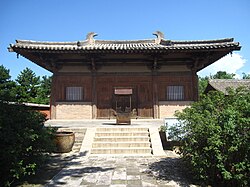Tang dynasty
The Tang dynasty (Chinese: 唐朝; pinyin: Tángcháo) (June 18, 618 – June 4, 907) was an imperial dynasty of China.
Tang 唐 | |||||||||||||||||||||||||
|---|---|---|---|---|---|---|---|---|---|---|---|---|---|---|---|---|---|---|---|---|---|---|---|---|---|
| |||||||||||||||||||||||||
 Tang dynasty c. 669. Map of China during the Tang Dynasty. | |||||||||||||||||||||||||
| Capital | |||||||||||||||||||||||||
| Common languages | Middle Chinese | ||||||||||||||||||||||||
| Religion | |||||||||||||||||||||||||
| Government | Monarchy | ||||||||||||||||||||||||
| Emperor | |||||||||||||||||||||||||
• 618–626 (first) | Emperor Gaozu | ||||||||||||||||||||||||
• 626–649 | Emperor Taizong | ||||||||||||||||||||||||
• 712–756 | Emperor Xuanzong | ||||||||||||||||||||||||
• 904–907 (last) | Emperor Ai | ||||||||||||||||||||||||
| History | |||||||||||||||||||||||||
• | June 18, 618 | ||||||||||||||||||||||||
• Usurped by Wu Zetian | 690–705a | ||||||||||||||||||||||||
• An Lushan Rebellion, also called the An–Shi Rebellion Traditional Chinese: 安史之亂) | 755–763b | ||||||||||||||||||||||||
• | June 1, 907 | ||||||||||||||||||||||||
| Area | |||||||||||||||||||||||||
| 715[1][2] | 5,400,000 km2 (2,100,000 sq mi) | ||||||||||||||||||||||||
| Population | |||||||||||||||||||||||||
• 7th century | 50 million | ||||||||||||||||||||||||
• 9th century | 80 million | ||||||||||||||||||||||||
| Currency | |||||||||||||||||||||||||
| |||||||||||||||||||||||||
a October 8, 690 – March 3, 705. b December 16, 755 – February 17, 763. | |||||||||||||||||||||||||
| Tang dynasty | |||||||||||||||||||||||||||||||||
|---|---|---|---|---|---|---|---|---|---|---|---|---|---|---|---|---|---|---|---|---|---|---|---|---|---|---|---|---|---|---|---|---|---|

| |||||||||||||||||||||||||||||||||
| "Tang dynasty" in Traditional Chinese characters | |||||||||||||||||||||||||||||||||
| Chinese | 唐朝 | ||||||||||||||||||||||||||||||||
| |||||||||||||||||||||||||||||||||
History
The Tang Dynasty came after the Sui Dynasty (隋) and was followed by the Five Dynasties and Ten Kingdoms Period (Traditional Chinese: 五代十國). It was founded by the Li (李) family, who came to power during the fall of the Sui Dynasty. The dynasty was interrupted briefly by the Wu Zhou (Traditional Chinese: 武周) usurper regime,[3] (October 16, 690 – March 3, 705) founded by Empress Wu Zetian (Traditional Chinese: 武則天) who managed to claim the throne, becoming the first and only Chinese Empress.
The Tang Dynasty, with its capital at Chang'an (Traditional Chinese: 長安) in present-day Xi'an (Traditional Chinese: 西安), was the biggest city in the world at the time. It is considered by historians as a high point in Chinese civilization – maybe even greater than the earlier Han Dynasty (Traditional Chinese: 漢朝) – as well as a golden age of cosmopolitan culture. Empress Wu, the first woman to ever rule in China, was also included in the Tang Dynasty. Her ruling methods were sometimes vicious, but she was very talented and intelligent.
Tang Dynasty Media
Portrait of Emperor Gaozu of Tang (566–635) dating to the Ming dynasty (1368–1644)
Wu Zetian, the sole recognised empress regnant in Chinese history
Mural depicting Tang architecture constructed in 707–710 – Mogao Grotto Cave 217
Construction of the Leshan Giant Buddha began in 713 and was completed in 803. The statue is 71 m (233 ft) high.
The Nanchan Temple built during the late 8th century
Xumi Pagoda, built in 636
A late Tang mural commemorating the victory of General Zhang Yichao over the Tibetan Empire in 848 – from Mogao cave 156
Emperor Xuanzong of Tang wearing the robes and hat of a scholar
Tang tomb figure of an official dressed in hanfu. He is depicted with a tall hat, wide-sleeved belted outer garment, and a rectangular "kerchief" in front. A white inner gown hangs over his square shoes, and he holds a tablet containing a report to his superiors to his chest.
A Ming-era painting by Qiu Ying depicting candidates for civil service gathered around the wall where examination results had been posted
Related pages
Other websites
- The Tang Dynasty at the Metropolitan Museum of Art
- Home of 300 Tang Poems, University of Virginia
- The Tang Dynasty Archived 2011-07-07 at the Wayback Machine at AsianSpiritGallery
References
- ↑ Turchin, Peter; Adams, Jonathan M.; Hall, Thomas D (December 2006). "East-West Orientation of Historical Empires". Journal of World-systems Research. 12 (2): 222. ISSN 1076-156X.
- ↑ Taagepera, Rein (1997). "Expansion and Contraction Patterns of Large Polities: Context for Russia". International Studies Quarterly. 41 (3): 475–504. doi:10.1111/0020-8833.00053. JSTOR 2600793. p. 492.
- ↑ which should be clearly distinguished from the Zhou Dynasty (Traditional Chinese: 周朝), which lasted from c. 1046 BC to 256 BC for 789 years during the classical antiquity.
+{{{1}}}−{{{2}}}









